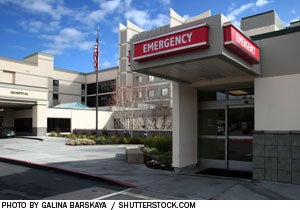Meeting of the minds focuses on preventing workplace violence
 Hospitals are moving rapidly to a more streamlined and cost-effective delivery system, but just how secure and safe will the care environment be if there isn't greater focus on preventing workplace violence?
Hospitals are moving rapidly to a more streamlined and cost-effective delivery system, but just how secure and safe will the care environment be if there isn't greater focus on preventing workplace violence?
About 130 leaders representing emergency nurses, security directors and others allied to the field met privately June 20 just outside Chicago to address the more ominous climate today in emergency departments (EDs) and elsewhere on hospital campuses.
"A lot of people truly don't understand the scope of workplace violence because it has been underreported and considered part of the job," said Bryan Warren, CHPA, 2012 president of the International Association for Healthcare Security & Safety (IAHSS).
Speaking at a press conference during a break in the conference that was not open to the press, Warren called on hospital executives to devote greater attention and resources to provide better, more professional security to enhance safety.
Among the changes he advocates:
- increasing training and education for security staff;
- implementing certification and security standards;
- deploying fundamental and integrated security system solutions — from wireless, multifunction panic buttons for nurses to sophisticated video surveillance systems to detect and deter violent situations;
- creating a culture in which security staff and clinicians see themselves as part of a team.
Gail Lenehan, 2012 president of the Emergency Nurses Association (ENA), emphasizes the need for hospitals to reassess how they view security. Image concerns, she says, should not override doing what is necessary to reduce violence in EDs, noting that emotional and psychological injuries during incidents are as real as physical ones.
Hospitals, Lenehan says, must work to create a security presence that is a "badge of honor" for the facility and recognized as such by patients.
Kevin Weeks, director of health care marketing for Tyco Integrated Security, one of the three organizations along with ENA and the IAHSS that launched the conference and sponsor of Health Facilities Management's annual Hospital Security Survey, laments the difficulty of trying to quantify violent episodes.
Underreporting of violence is commonplace, Weeks and the others note. Likewise, it's difficult to measure how often violence is prevented due to security staff actions, technology or other factors.
"It's exceedingly difficult to sit down with a CEO or CFO and articulate all of these things," Weeks says.
One fact that Weeks says must not be overlooked comes from the National Institute for Occupational Safety and Health (NIOSH), which sent a representative to the conference. NIOSH reports health care led all other industry sectors in lost work days due to workplace violence.
Panelists at the conference discussed specific security measures ranging from the potential use of armed security personnel in the ED to metal detectors to stem violence, but Weeks says there was little support for these options.
Although no agenda for the future emerged from the meeting, Weeks is confident there will be more discussions.
"I'm fairly confident we'll continue to hold meetings like this ... until we don't need to anymore," Weeks says.




